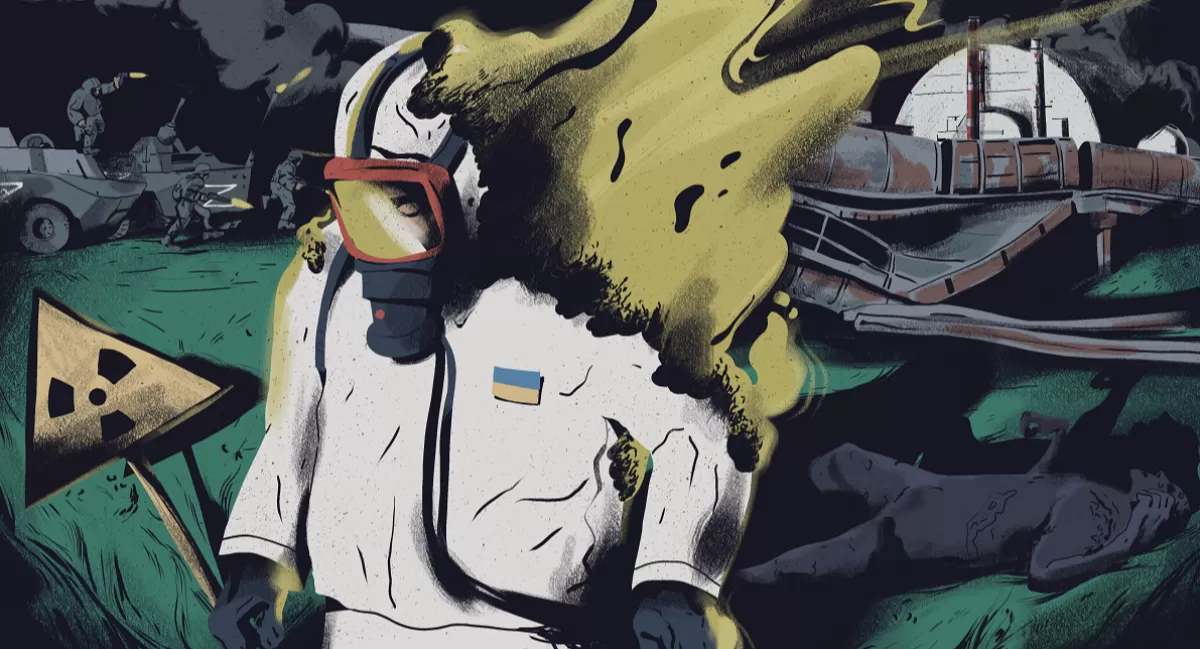
Russia’s invasion of Ukraine brought the world closer to a nuclear disaster, as Russian troops occupied Ukrainian nuclear power plants – sometimes by fighting their way in and shooting at the plants – and Russian missiles flew dangerously low above them. Yet, the International Atomic Energy Agency had a rather moderate response to these risks and it continued to work closely with the Russians, much to the dismay of the Ukrainians.
A Moment Before the Catastrophe
It took several hours for Russian troops to seize territory as big as Luxembourg. They needed to do only two things. First, to take out with artillery fired from Belarus the border guards, who were only armed with assault rifles. Second, to just send a giant column of tanks charging through an empty forest towards the gates of the Chornobyl Nuclear Power Plant, which was guarded by about 150 lightly armed troops from the National Guard.
The nuclear power plant is not a place for hostilities. It stores 2,500 tons of spent nuclear fuel - 12 times more than in 1986, when one of the reactors exploded, triggering the biggest civil nuclear disaster in history. That is why the Ukrainian National Guardsmen were forced to surrender without fighting. After all, if Russian tanks would start firing, just one wrong hit at the nuclear facility could lead to a global catastrophe.
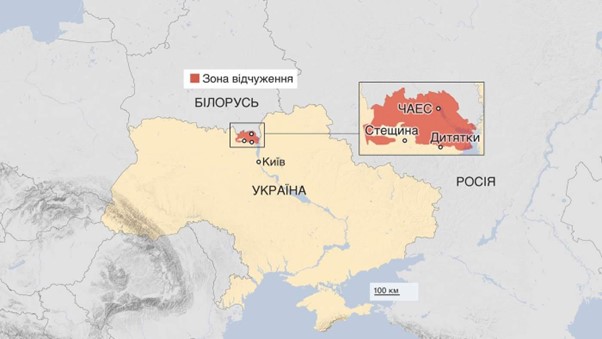
The Russian troops tried to advance to the capital of Ukraine along the shortest and most dangerous way - through the radiation-contaminated Chornobyl Zone. Photo by Energoatom
The fact that the nuclear power plant survived may be called a miracle. The Russian army used it not as a civilian but as a military facility for 36 days. Forgetting about all possible rules of law and international obligations, the Russians began to build deep trenches around the perimeter of the exclusion zone, fortifications for tanks and cannons. Next to the blown up Fourth Reactor, a command post was built.
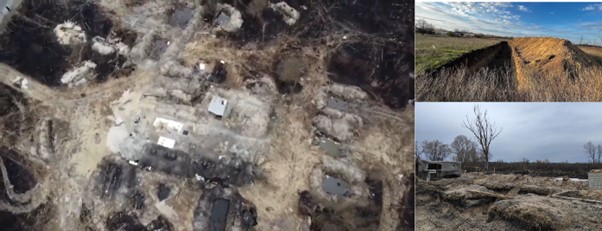
Energoatom has published drone photos showing objects resembling military fortifications and trenches in the Red Forest, one of the most radioactive places in the exclusion zone. Photo by Energoatom
For more than a month, the Chornobyl Nuclear Power Plant was an ammunition storage site, and the surrounding area – a battlefield facing constant shelling, destruction, pressure on the population and killings.
On March 9, during the fighting, the Russians damaged the power supply of the Chornobyl NPP and the storage of spent nuclear fuel, sufficient for 13 nuclear reactors. The Energoatom Company warned that prolonged blackouts at the storage facility could lead to overheating and evaporation of radioactive substances. As a result, radiation could contaminate not only Ukraine but the whole of Europe, as well as Belarus and Russia.
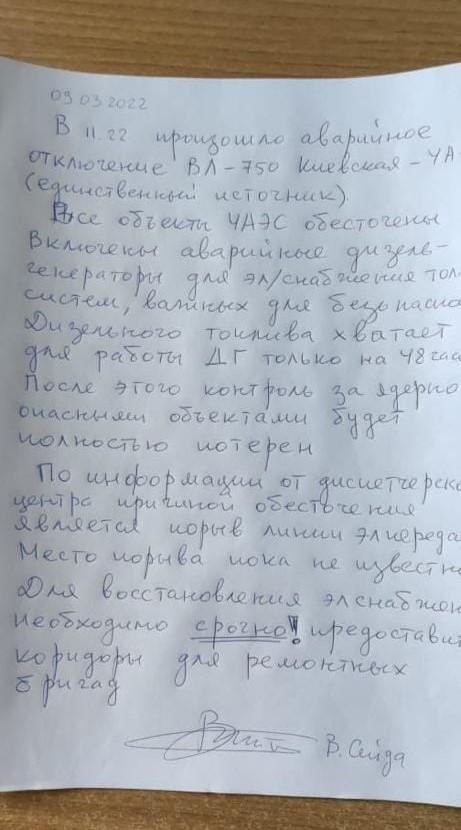
Report during the accident at the power supply lines at the ChNPP on March 9, 2022. Photo by Energoatom
When the NPP was captured, about 2400 of its employees became hostages of the occupiers. These people were the only ones to take care of radiation safety as best as they could. ChNPP engineer Valeriy Semenov recalls how during the power outage he tried to find fuel to maintain the generator – and at his own risk he stole it from the Russian military. Fortunately, four days later Ukraine resumed the power supply.
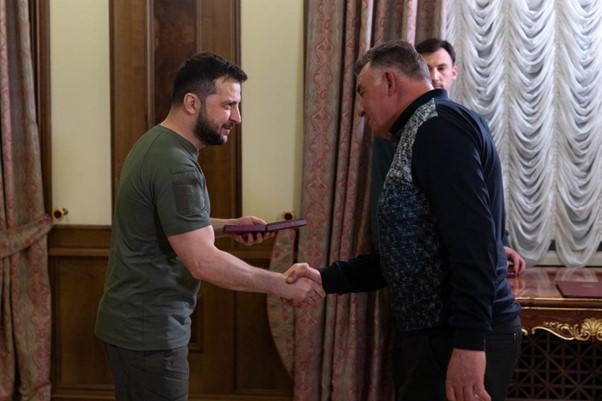
On the 36th anniversary of the Chornobyl tragedy, President of Ukraine Volodymyr Zelensky presented national awards to employees of the Chornobyl NPP who maintained safety at the NPP and worked 600 hours in a row at the end of guns and without rest. Photo - Office of the President of Ukraine
The Russian Federation’s complete unwillingness to consider the consequences of a possible catastrophe is showcased by the fact that the Russian army did not even care about their own safety: the military did not use protective clothing, dosimeters or personal protective equipment. During the occupation, hundreds of Russian vehicles passed through the radiation-contaminated area. At the same time, the occupiers moved along routes that are prohibited for use due to high levels of radiation, and in certain directions they conducted large-scale hostilities.
Russian occupation forces at the ChNPP
“No radiation control of vehicles and servicemen was carried out,” according to Anatoliy Nosovsky, director of the Institute for Nuclear Safety of the National Academy of Sciences of Ukraine. “And the vehicles themselves moved not only on asphalt roads, but also on the ground, raising radioactive dust. Therefore, after their capitulation, they took radioactively contaminated equipment to their military bases. "
Energoatom commented on the long-awaited withdrawal of Russian troops from the Chornobyl Zone not only with joy but also with sarcasm: "Organised convoys have left the Chornobyl NPP and its satellite town of Slavutych. Only the most ‘resistant’ invaders have stayed yet. The most greedy, to be precise. Those who within record-breaking undertime struggle to grab everything that possesses any value. A sort of a sign-off of the ‘special operation’.”
Maksym Shevchuk, the Deputy Head of the State Agency of Ukraine for Exclusion Zone Management, says that looting was an integral part of the occupiers' work schedule: "The Russians had an accurate schedule: every day from 10 a.m. to 2 p.m. they walked around looting. During the 35 days of occupation, they entered the buildings several times.
Anatoliy Nosovky shows the result of the invading troops’ presence in his laboratory facilities in Chornobyl: doors are broken off, windows smashed, metal safes broken into and looted. ”And this is an empty closet, in which there was a server for radiation situation monitoring“, he shows. “It was stolen. Laboratory equipment was robbed and destroyed. Memory cards were stolen from computers.”
While tidying up their laboratories and offices, scientists are sad to note that apart from office equipment, Russian troops have destroyed documents and archives that professionals have been collecting for decades.
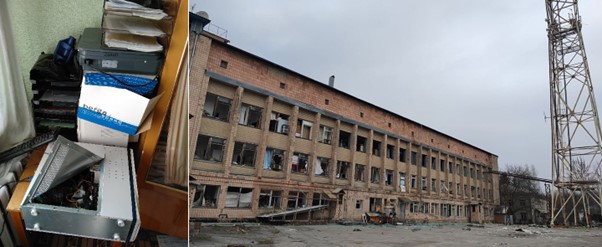
The effect of the Russian troops’ presence on the ChNPP site. Photo by Energoatom
Other enterprises on the territory of the ChNPP have the same appearance. Because of the signs of shelling, offices and dormitories in Chornobyl resemble a sieve. The whole infrastructure is damaged, including bridges, roads, and communication. The Russians stole more than 200 specialised vehicles, including those for carrying radioactive waste and fighting forest fires.
According to Energoatom estimates, the Russian army during the month of their stay in Chornobyl alone caused losses of tens of billions hryvnias. In addition, they left behind mined areas.
Working With the Missiles Whizzing Around
The decision to expose the whole world to a nuclear catastrophe was made at the highest level of the Russian leadership. Thus, the order to shell the largest nuclear power plant in Europe, Zaporizhzhia NPP, was given by Major General Alexey Dombrovsky, Deputy Chief of the National Guard of the Russian Federation in Krasnodar Krai. The Office of the Prosecutor General (OPG) of Ukraine has already served him in absentia with the notice of charges of violating the laws and customs of war combined with murder.
"As a commander he took part in the capture of the city and nuclear power plant together with two battalion tactical groups of the Armed Forces and the National Guard of Russia. As a result of the enemy attack, four Ukrainian citizens were killed , technologically important networks and communications were destroyed," the OPG informs.
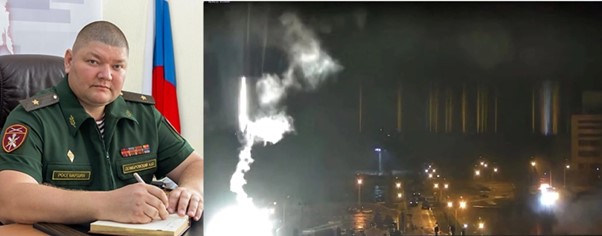
Russian Major General Alexey Dombrovsky led the operation to capture the town of Energodar, where the ZNPP is located. Author's photo collage
During the shelling, the nuclear plant personnel tried to "reach" the invaders through a loudspeaker and warning system: “Cease firing on the nuclear danger facility! You are threatening the safety of the whole world!” But the Russian Army didn’t heed their calls: around 50 shells hit the NPP’s power units and adjacent buildings, but fortunately the ammunition didn’t explode. Besides, several buildings were completely destroyed. Among them, the ZNPP Training and Education Centre and Atomenergomash, a service division that used to manufacture and repair the equipment for the power plant.
"As a result of the invasion and the shelling of sites, an external threat to the lives of ZNPP employees arose” according to Danylo Lavrenov, the Secretary of the Ukrainian Nuclear Society, one of the largest sectoral organisations in Europe. Lavrenov added that equipment, buildings and infrastructure elements were damaged significantly, and all that lead to an increased threat of a nuclear accident.
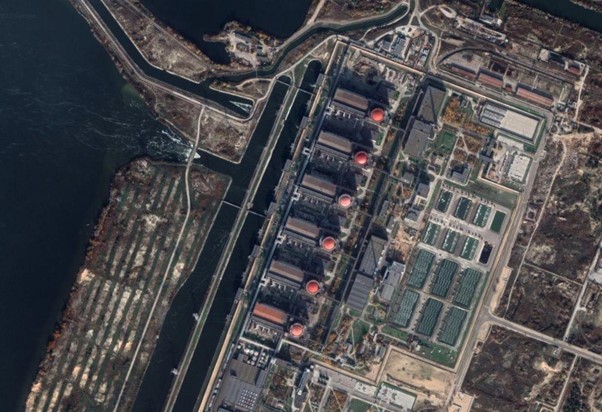 April 28, 2022, the Russian troops damaged the high-voltage line of the Zaporizhzhia NPP. Because of this, the power plant was switched to the minimum level of capacity - sufficient only to provide power for their own needs. Photo - Google Maps
April 28, 2022, the Russian troops damaged the high-voltage line of the Zaporizhzhia NPP. Because of this, the power plant was switched to the minimum level of capacity - sufficient only to provide power for their own needs. Photo - Google Maps
“A licence to operate an NPP is issued on the grounds of a safety report, which clearly stipulates safety conditions. But these safety conditions do not exist today, and the facility is working”, according to Mykola Shteinberg, a nuclear energy expert who has worked for many years at Ukrainian nuclear power plants. “That is, the entire ZNPP is outside the legal framework. We do not have international agreements, treaties, conventions that discuss the operation of nuclear power plants in wartime. The international nuclear security regime is absent and destroyed. And this issue needs to be addressed around the world. "
The reckless seizure of the Zaporizhzhia NPP shocked the whole Ukrainian society. The President of Ukraine, ministers and MPs appealed to international partners and organizations to stop acts of “nuclear terrorism” in Ukraine and to designate the Russian Federation as a nuclear terrorist country.
"The way the Zaporizhzhia plant was seized, it was simply an out, the nuclear terrorism in its true colors," comments Minister for Energy German Galushchenko. “The occupiers fired from tanks and mortars. Then the shells that did not explode were collected, taken beyond the perimeter of the power plant and blown up under the training building, which is also insanity in terms of nuclear safety. There can be no nuclear safety when shells are near nuclear reactors!”
Now there are representatives of the Russian state corporation for nuclear energy Rosatom, the Rosguardsmen and the FSB at the Zaporizhzhia NPP. Acting Director of NNEGC Energoatom Petro Kotin said that the day of the nuclear power plant was captured, representatives of the so-called military-civil administration came to the plant, gathered its management and said that it was now a Rosatom plant, and it no longer belonged to Ukraine; they said they had come there to stay, so the nuclear power plant has to operate in accordance with Rosatom's decrees.
At the entrance to the ZNPP, all employees are carefully checked by armed troops, and their phones are confiscated. According to Kotin, there are 11 Rosatom employees: “They work in the crisis centre and almost never leave it. They don’t take part in the operation of the plant and are mainly engaged in the study of documents and regulations. By the way, the very fact that the Russians are in the crisis centre is already a violation. After all, the crisis centre is used in case of an emergency: the leadership has to move there and operate the power unit from there”.
And an emergency can happen at any moment: hostilities in the Zaporizhzhia Oblast are ongoing, and Russian missiles regularly fly over the nuclear plant. The Russian units are now headed by the head of the Chemical, Biological and Radiological Protection Forces of the Armed Forces of the Russian Federation, Major General Valeriy Vasilyev. He and several hundred other Russian servicemen constantly quarter at the power plant, with dozens of military vehicles and loads of ammunition. And Andrey Gorbunov, the chief engineer of the Russian Rostov NPP, declared himself the Russian leader of ZNPP.
ZNPP employees work under intense pressure. They are not allowed out of the city, they are interrogated, and are constantly being told that the actions of the Armed Forces of the Russian Federation in Ukraine are of self-defence. The occupying power has announced that it will write off all debts on bank loans, utility debts, and the cost of gas and heating will decrease to Russia's level. The people are asked not to take part in rallies, and when they do gather to protest, Russians fire their arms. Leaflets spread around the city state that "Our goal is to hold a referendum and create conditions for the unification of the Russian Federation and Ukraine, two fraternal peoples”.
Russian authorities have been trying to put puppet collaborators in leading positions. Thus, ZNPP engineer Andriy Shevchyk proclaimed himself the chairman of the newly created “Civic Council of the Town Self-Organisation”, which was to perform the functions of the town government in cooperation with the Russian occupiers. After that, the Zaporizhzhia Oblast Prosecutor's Office served him with the notice of charges of treason.
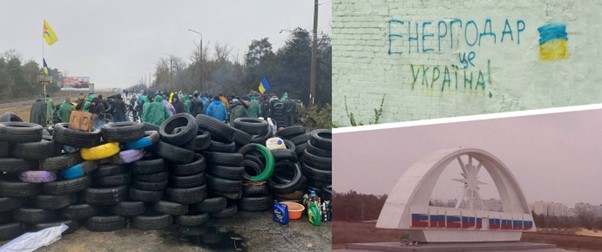
Residents of Energodar tried not to let the occupiers into the town: thousands of people blocked the road to Russian vehicles. After that, the Russians began firing on people, and eventually captured the town. Despite the fact that the occupiers repainted the name of the town at the entrance to the Russian tricolour, the city residents paint patriotic inscriptions in blue and yellow - as a sign of resistance to the Russian occupiers. Photo - telegram channel "Energodar"
During the open online marathon "Challenges of Ukraine's nuclear energy in wartime", Yaroslav Yemelyanenko, a representative of the Chornobyl Tourism Association, read out a written appeal from Energodar residents to the world: "We, Energodar residents, come to work because the power plant has to operate. But we work at rifle and machine-gun point. It's very difficult in terms of morale. People can't risk rallies because of the threat of terrorist attacks on ZNPP. It's about the safety not only of our people, but of the whole world. The orcs must leave the city. We are waiting for the reaction of the whole world."
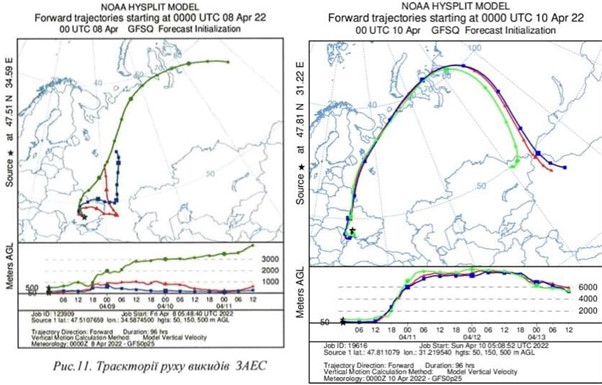
Ukrainian scientists from the Radiation Accident Forecasting Centre under Ukrhydrometcentre calculate the trajectory of the spread of polluted air in the event of an accident at the Zaporizhzhia NPP. Radiation can spread thousands of kilometres in the direction of air masses moving on the day of the disaster. Photo by the author.
Grossi’s Parallel World
During the first three months of the war in Ukraine, Russia’s missiles flew over four nuclear power plants: Chornobyl, Zaporizhzhia, Khmelnytsky, and the South-Ukrainian. Lately, Russia has used low-precision missiles for bombardments. As a result, missiles worth millions of dollars hit rivers, playgrounds and public toilets instead of military facilities.
Therefore, the probability of a "random" missile hitting a nuclear reactor is very high.
In the language of the UN Security Council, the situation sounds like a "global threat to nuclear security." And in simple words, the world is on the verge of a nuclear catastrophe.
"This is the first time in history that a nuclear-developed country has suffered such aggression. This is an act of nuclear terrorism, when the occupiers shelled our nuclear facilities. This has never happened before, and no one expected that it could happen,” explains Petro Kotin, Director General of the Zaporizhzhia NPP.
The Russian Federation and Ukraine are parties to the International Convention for the Suppression of Acts of Nuclear Terrorism and the Convention for the Physical Protection of Nuclear Material. These documents state that it is a crime to use or damage a nuclear facility in such a way as to endanger the release of radioactive material.
The world regulator in the field of nuclear safety is the International Atomic Energy Agency (IAEA). Its inspectors must determine whether nuclear facilities are or are not being used for military purposes. And it is this organisation that should be the first to declare a global threat to nuclear security due to the shelling of Ukrainian nuclear power plants by Russian troops, and immediately turn to the UN Security Council. At least so says its charter.
The UN Security Council is a permanent body of the United Nations with responsibility for maintaining international peace and security. In practice, this means that the Security Council can: 1) apply sanctions against the violating state, 2) conduct military operations against the aggressor state, 3) introduce peacekeeping formations in conflict zones. At the same time, the decisions of the Security Council are binding on all states that are members of the UN.
However, the IAEA failed to appeal to the UN Security Council. Watching the events in Ukraine day after day, IAEA chairman Rafael Grossi called the safety situation at the Ukrainian nuclear power plants "stable." When it comes to missiles flying over the Zaporizhzhia NPP, Grossi told reporters that "we are checking this. We have to be one hundred percent sure."
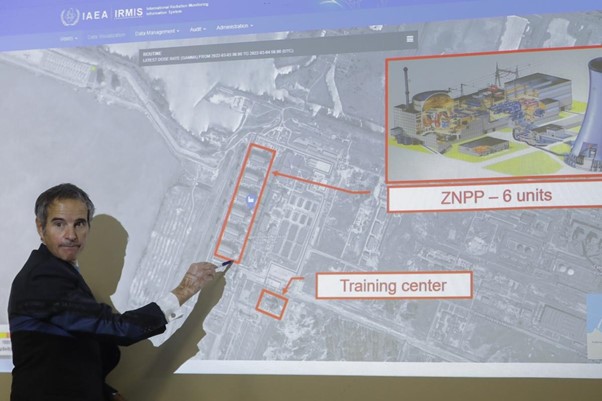
IAEA President Rafael Grossi calls the situation at Ukrainian nuclear plants stable and assures: “Zaporizhzhia ranks first on the list of what worries me when it comes to the situation with nuclear facilities in Ukraine”. Photo by the author.
Ukraine cannot convene an emergency session of the UN Security Council either, because she is not a member of this collegial body. The Ukrainian authorities instead made a public address to the IAEA and a number of international organizations calling to designate the activities of the Russian Federation as an act of nuclear terrorism and help in creating 30-km demilitarized zone around nuclear facilities, free of tanks, military men, or ammunition stockpiles. Also, the Ukrainians asked that missile no longer fly over nuclear facilities.
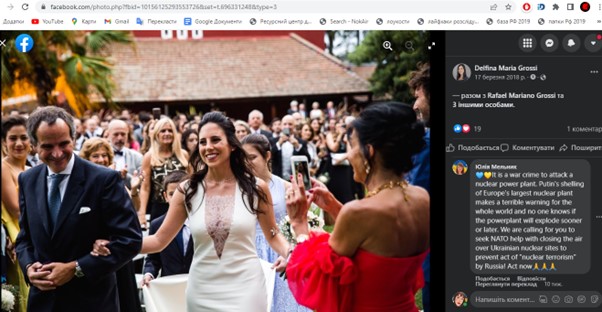
Not only does the IAEA receive the official appeals from Ukraine on the disastrous situation at the NPP due to the Russian aggression. Users leave hundreds of comments under each post on the IAEA head Rafael Grossi’s Facebook page with the only call to protect Ukraine from the nuclear terrorism of the Russian Federation. Grossi doesn’t reply on these comments. Photo by the author.
“I told Grossi that for us, the political signals from IAEA are important — there aren’t neutral positions at war,” explains Ukraine’s energy minister German Galushchenko. “We insisted that the first and primary element of nuclear safety is the withdrawal of the Russian military from our nuclear facilities. We cannot speak of nuclear safety while the Russian invading troops are there.”
However, the IAEA stand is optimistic. During his visit to Ukraine Grossi thanked the NPP workers for their “endurance and firmness in these extremely hard times” and presented them dosimeters and accumulators.

Rafael Grossi visiting the Chornobyl NPP in April 2022. He brought dosimeters as presents. Photo by Energoatom
Later the IAEA publicly stated that they are going to assist Ukraine by granting her equipment for nuclear facilities, radiation measuring devices, protective materials and diesel generators. And the Ministry of Health of Ukraine noted that the IAEA asked them for a report about the impact of the actions of Russian troops at NPPs in order to help them find funds to compensate for damage.
Two weeks later, at the joint session of the Foreign Committee and Defence and Security Sub-Committee of the European Parliament Grossi one more time reassured everyone: “We concluded that levels of risks have increased a little, but they are far from dangerous situations.”
It is rather strange to hear that from Grossi. After all, he understands well how dangerous nuclear weapons and nuclear facilities are. As a student he visited the Japanese cities Hiroshima and Nagasaki that experienced atomic bombardments. In his interview for the Japanese media he recalled how he was stunned by meeting survivors of the atomic bomb: “I was touched by this experience…”
So why hasn’t the IAEA condemned the Russian invasion of Ukraine yet, and continues to collaborate with Rosatom?
Russia’s people in the IAEA
The IAEA is an enormous entity where about 2600 employees from more than one hundred countries work.
Since 2019, the organisation is led by Argentinian Rafael Grossi. One of his six deputies is Russian Federation citizen Mikhail Chudakov. This graduate nuclear engineer previously held a number of executive positions in the Russian atomic enterprise Rosenergoatom and worked on various posts at NPPs. And now he leads one of the key IAEA subdivisions, the Department of Nuclear Energy. The Department’s objective is to support the current and emerging nuclear programmes around the globe.

The IAEA maintains warm relations with Rosatom representatives even after Russian troops seized Ukrainian nuclear power plants. On the left photo - Rafael Grossi and the representative of the Russian Federation in the IAEA Mikhail Ulyanov (far left), on the right photo - Rafael Grossi (on the photo he stands on the right) and the Minister of Foreign Affairs of the Russian Federation Sergey Lavrov. A red line highlights a photo of IAEA Deputy Chairman, Russian Mikhail Chudakov. Photo - IAEA
Apart from Chudakov, there are other Russians in the IAEA management who influence the body’s decision-making, says Petro Kotin. Therefore, during the meeting with Grossi, the Ukrainian side insisted that the IAEA asked the representatives of Russia's Rosatom to leave the Ukrainian nuclear power plants immediately, and that citizens of the Russian Federation would not participate in decision-making and international missions in Ukraine.
Instead, Grossi not only failed to suspend the Russians from Ukrainian issues, but, on the contrary, agreed with Rosatom on "cooperation to ensure the maximum safety of nuclear facilities in Ukraine."
The State Nuclear Regulatory Inspection of Ukraine was outraged by this decision, to put it mildly: “The acts of nuclear terrorism committed by Russia on the territory of Ukraine are incompatible with safety issues and in general the aggressor country cannot speak of any, let alone nuclear and radiation, safety.”
However, it seems that the IAEA is not very worried about the critical remarks of Ukrainian nuclear scientists. While Russian missiles flew over Ukrainian nuclear power plants, Rafael Grossi met several times with representatives of the Russian Federation without Ukraine's participation. And after any meeting, the IAEA did not express dissatisfaction with the actions of Russian troops and did not call on Russia to stop using weapons near nuclear facilities.
On March 9, at the meeting with the IAEA Board of Governors, Mikhail Ulyanov, Russia's permanent representative to the organisation, justified shooting on the Zaporizhzhia NPP’s premises, because “the Russian units guarding the plant’s perimeter were attacked by the Ukrainian saboteurs and were forced to drive them away by fire in response. However, he did not provide any evidence that those saboteurs did exist.
On April 1, in Kaliningrad, Russia, Grossi met with ROSATOM CEO Alexey Likhachev. There they discussed the safety of Ukraine's nuclear facilities. After the meeting, Grossi not only failed to demand leaving the Ukrainian atomic facility, but, quite the contrary, thanked Likhachev "for efficient cooperation and partnership":
"I can say generally that the situation is under control, but there are things that need clarification. The agency will work to clarify the situation and assess it," Grossi said.
On May 4, Grossi met Likhachev, this time in Istanbul. During this meeting, the IAEA representative asked the Russians to organise a technical mission to the Zaporizhzhia nuclear plant for the agency's specialists. As if Russia was the owner of this plant.
Expressing its good attitude towards Russia, despite the war of aggression, the IAEA continues to invite to its conferences and working groups representatives of a key Russian state body that regulates nuclear facilities - the Federal Service for Environmental, Technological and Nuclear Supervision (Rostekhnadzor).
Thus, on April 11, Rostekhnadzor discussed with the IAEA amendments to the Convention on the Physical Protection of Nuclear Facilities.
On April 13, Rostekhnadzor voiced its ideas on nuclear safety during a meeting of the steering committee and working groups of the IAEA Forum on Small Modular Reactors.
On April 22, Rostekhnadzor took part in the 51st meeting of the IAEA Commission on Security Standards. On the same day, Russian scientists presented 70 reports at the IAEA conference on FR-22 fast reactors.
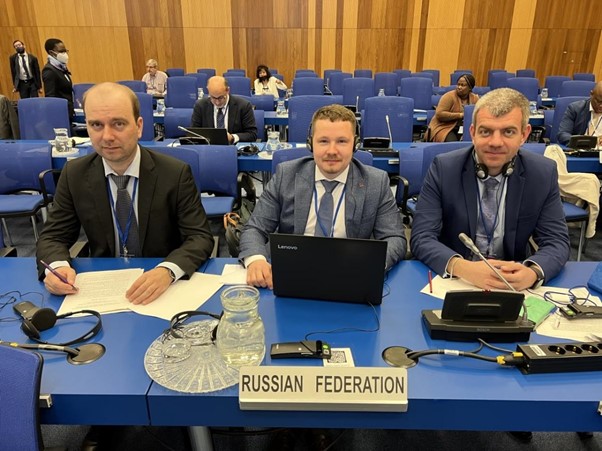
On May 4-6, 2022, the IAEA hosted the Fourth Extraordinary Meeting of the Contracting Parties to the Joint Convention on the Safety of Spent Fuel Management and on the Safety of Radioactive Waste Management. Representatives of the Russian Federation also took part in this meeting. Photo - www.atomic-energy.ru/
On May 12, the executives of Rostekhnadzor and the IAEA held a meeting on the international "initiative for harmonisation and standardisation in the field of nuclear energy." At the time, Rafael Grossi stressed that "the participation of Russia, a country that is actively developing the nuclear energy sector, is very important for the successful achievement of this goal."
Iran is More Important
Analysing the statements and actions of the IAEA, it becomes obvious that currently the biggest headache of this organisation is not Ukraine, but Iran, which is one step closer to the creation of nuclear weapons. Iran herself produces uranium - the main element of a nuclear bomb. At her plants, Iran enriches uranium at 20% level. At the same time, the representative of the Atomic Energy Organization of Iran Behruza Kamalvandi claims that Iran can "easily" increase uranium enrichment to 90%. For comparison: to create a nuclear bomb, the uranium content must be at least 80%.
IAEA is determined to stop Iran from developing nuclear weapons. And it seems that for this purpose the IAEA is ready for anything.
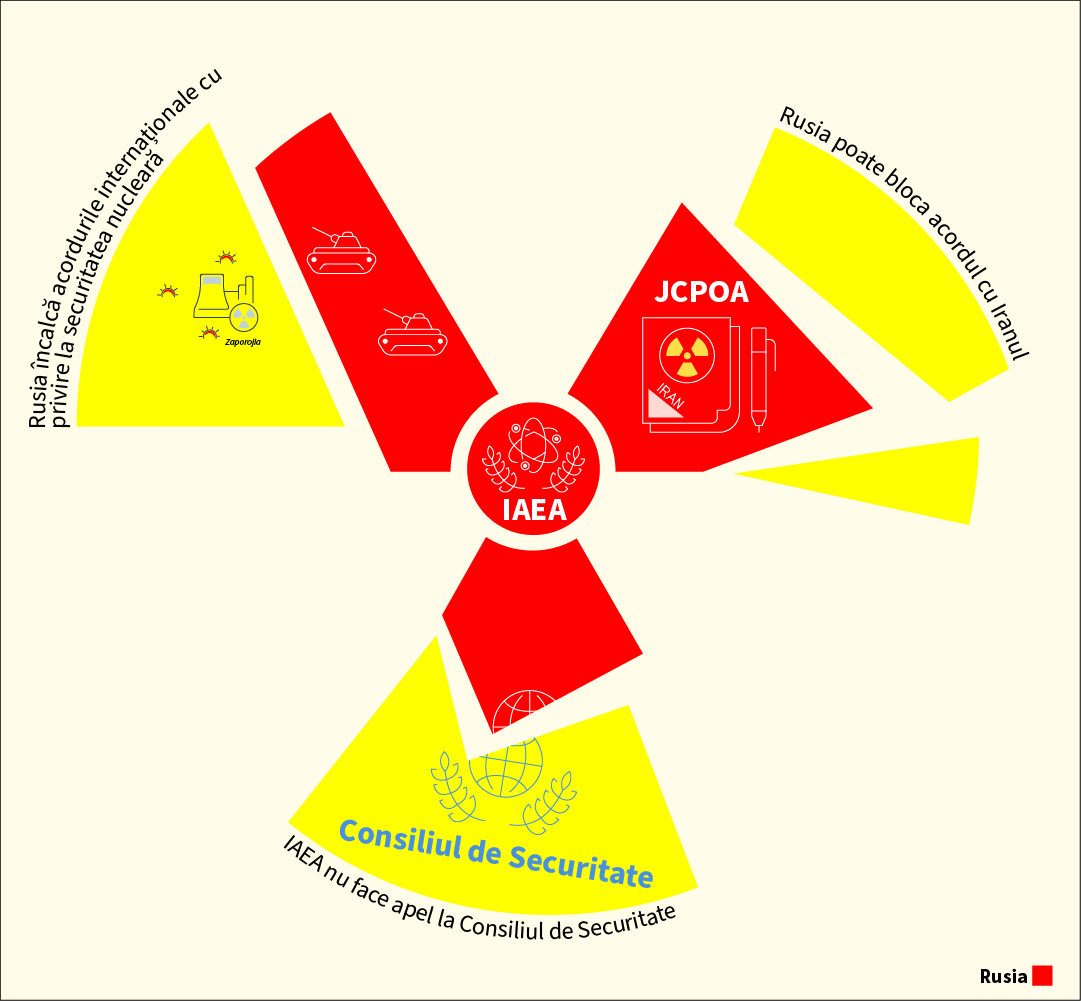
Artboard: Veridica/Iulian Preda
Rafael Grossi is not a nuclear energy scientist, but a certified diplomat. And, holding various positions, he devoted many years to resolving the "Iranian issue." As deputy head of the IAEA in 2010-2013, Grossi failed negotiations with Iran over its controversial nuclear program.
So right now he has a chance to show his effectiveness in this matter.
Iran and six international mediators (the USA, Russia, Britain, France, the PL of China, and the FRG) have been trying for many months to resolve differences over Iran's nuclear program by agreeing on a Joint Comprehensive Plan of Action (JCPOA). In 2022, the IAEA plans to test whether Iran is fulfilling its obligations to the UN Security Council not to develop nuclear weapons.
At last the parties to the agreement were able to round off all rough corners: they introduced important restrictions on the nuclear program and lifted economic sanctions against Iran.
For the agreement to work, all parties must sign it. In particular, the signature should be put by a representative of the Russian Federation - a reliable partner and ally of Iran. But the question is, whether Russia will want to do so if the IAEA openly criticises it and dismisses Russian personnel from working in the organisation for its aggression at Ukrainian nuclear power plants?
Moreover, the IAEA is well aware that Russia, like no other country, can influence Iran's capricious position. After all, Russia and Iran are long-standing partners in the field of nuclear energy. Rosatom built the first and the only NPP in Iran so far. And now Iran is completely dependent on supplies of Russian nuclear fuel for this NPP. In addition, only Rosatom provides services to support the safe operation of existing nuclear facilities.
In addition, Russia is responsible for controlling Iran's enriched uranium surplus and transforming the Fordow uranium enrichment plant into a research facility. In other words, she is making sure that the Iranians do not develop nuclear weapons under the guise of scientific research.
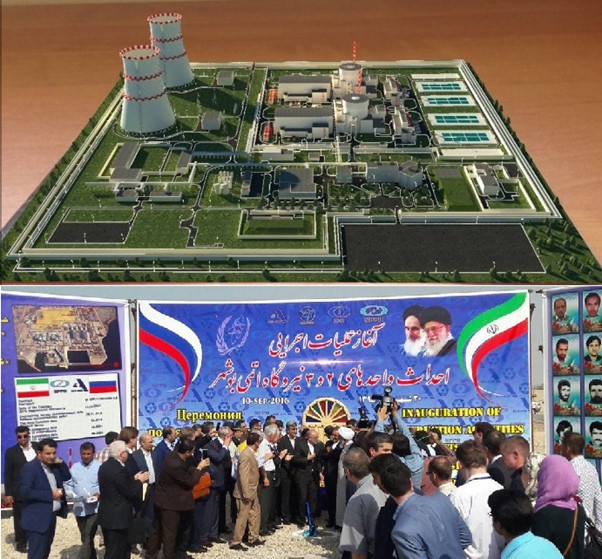
The ceremony of the beginning of works on the construction site of the Bushehr NPP power unit 2 with the participation of Russia in Iran, 2016. Photo by Rosatom
That is why it is always emphasised during the meetings of the Rosatom management and Grossi that the conversation, “as always, was warm, business-like and very focused. Russia and the IAEA are time-tested partners.”
The IAEA continues to meet with the Russian leadership in order to discuss Iran's nuclear program, even during the aggressive invasion of Ukraine by Russian troops. That is why the IAEA does not respond to Ukraine's request to exclude Russian representatives from the organisation's management.
Instead, Grossi meets with Russia's representative in IAEA Mikhail Ulyanov a few days after Russian troops shell Europe's largest nuclear facility, the Zaporizhzhia NPP. The Iranian issue is apparently more important to the IAEA now than a potential nuclear disaster.

